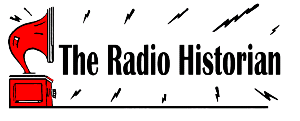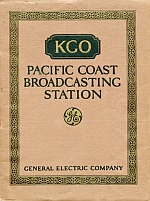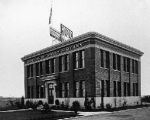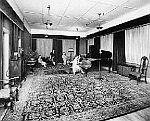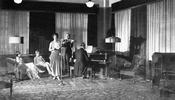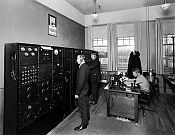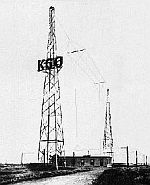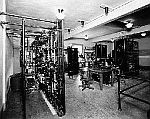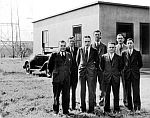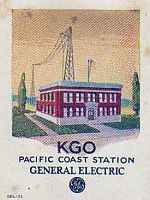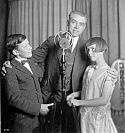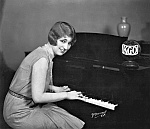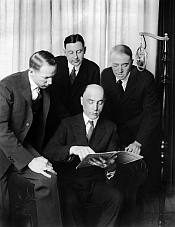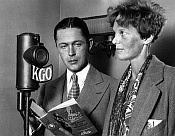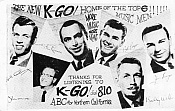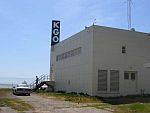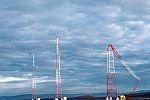The History of KGO,
Oakland, California
By
John Schneider, W9FGH
Copyright 1996; updated 2018
www.theradiohistorian.org
Copyright 2015 -
John F. Schneider & Associates, LLC
(Click on photos to enlarge)
KGO Studio Building, Oakland, CA, 1924
Another view of the KGO
Main Studio, 1926
KGO Transmitter Building and Antenna, Oakland, CA, 1924
KGO 7,500 watt Transmitter, 1924
KGO transmitter engineers pose in front of transmitter building - 1934
Howard Milholland, KGO Manager
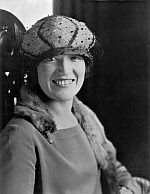
Rose
Brown, leading lady of the "KGO Players"
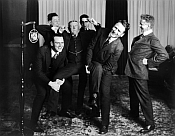
KGO broadcast,
"The Royal Mounted", 1924
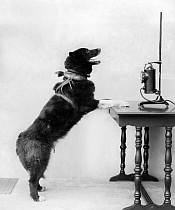
Famous sled dog "Balto" visits KGO

An
Advertisement for the KGO program "Let There Be Music", 1930s
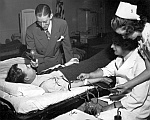
KGO's Bill Baldwin at a 1942 blood drive
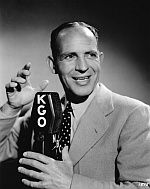
KGO sport announcer
Ernie Smith
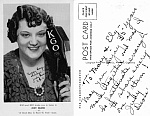
Some KGO performers of the 40s
Views of the KGO transmitter site in 2006
The General Electric Company had been one of the giants of the electrical industry since its founding by Thomas A. Edison in the nineteenth century. After conquering the worlds of power generation and electric lighting, the company became one of the pioneers in the radio field as a partner with Westinghouse in the new RCA manufacturing conglomerate. As a major early manufacturer of radio receivers, they, like Westinghouse, saw the value in operating broadcast stations to promote the sale of radio receivers. General Electric constructed and operated WGY at its manufacturing facility in Schenectady, New York in 1922.
With the success of WGY, General Electric began making plans to build two other high-powered radio stations. One station was to cover the mountain and plains states, while the third was to be heard on the Pacific Coast. They immediately began investigating the San Francisco area as a base for the Pacific station, because of its location midway along the coast, and because of the ample supply of musical talent in the area. Originally, General Electric announced plans to build the station on Telegraph Hill in San Francisco, and had drawn up plans for several ornamental antenna structures to be built there. However, they finally settled on a site in Oakland, at a G. E. power transformer manufacturing facility there, located at East 14th Street and 55th Avenue. At the time, what is now known as East Oakland was only sparsely populated, and G. E. had just completed their sprawling plant on a 24-acre site earlier that year.
Construction was begun on the studio and transmitter buildings in June of 1923, about a year before the company's third station, KOA in Denver, was begun. The license was applied for and the call letters KGO assigned. Those call letters had previously been held by a radio store in Altadena, near Los Angeles. That station had gone off the air after less than a year of operation.
Meanwhile, newspapers in the area were heralding the coming of a great new super-station to the Bay Area. The "Examiner" headlined, "Plans Ready for Biggest Radio in the West". It announced that the new thousand-watt station would be strong enough to "throw the human voice one third around the world ... more powerful than any station west of Schenectady, New York," referring to G. E.'s eastern operation.
KGO first took to the air January 8, 1924. A beautiful new two-story brick building had been constructed expressly to house the studios, and the transmitter building and antenna were at the opposite end of the plant. On the first floor of the studio building were the station offices: Program Manager, correspondence room, and a reception room for visitors. In the rear of the building was the power room, containing banks of storage batteries and large generators, which were used to power the amplifying equipment in the control room upstairs. On the second floor there were two studios, the second considerably smaller than the first, and both equipped with ample soundproofing and a ventilation system. There was also a large control room between the studios, equipped with a loudspeaker to monitor what was taking place in the studios. Three operators were always on duty in the control room -- two to keep the equipment running properly and to maintain a constant output volume, and a third to listen for distress calls from ships at sea on a separate receiver. In the event of a distress call, all coastal stations of the period were required to shut down, clearing the radio bands for emergency traffic.
The transmitter building was located about a thousand feet away from the studio, and the buildings were connected by several cables carrying the program audio plus a system of signal lights and an intercom. It was a small one-story stucco building that housed six power generators in one room and three transmitters in the other. KGO was one of the few stations then to have a duplicate of every piece of transmitting equipment, so that the station could stay on the air in the event of equipment failure. This was the purpose of two of the three transmitters. The third was for communicating with ships in distress, and was kept on standby at all times. The two 150-foot steel towers that supported the antenna straddled the transmitter building, one on each side, at a spacing of 260 feet, so that the antenna was strung directly over the structure. Twelve counterpoise wires were hung parallel to the antenna fourteen feet above the ground and covering an area of 150 x 300 feet. The letters K-G-O were mounted in large illuminated figures on the side of one tower. For its time, the station represented the epitome of technology.
KGO went on the air initially on a schedule of 8 to 10 PM every Tuesday, Thursday and Saturday. Immediately, it developed a reputation among its listeners for having consistently
high program quality. Some of the top musical artists in the Bay Area were enlisted to perform over KGO by Studio Manager Howard Milholland. Indeed, most of the program staff itself was musically inclined. Milholland and three other staff members formed a quartet that was heard frequently over the air waves. Announcer Jennings Pierce, who later announced for NBC, was a very fine tenor. Carl Rhodehamel, Publicity Manager, directed the KGO Little Symphony. In fact, it is quite possible that KGO required all its staff members to have musical abilities.
One of KGO's most popular programs was Ann Holden's Home Forum, which began shortly after the station's first broadcast, and continued to be a regular KGO feature until 1962. The original Ann Holden, whose real name was Flora Davis, was replaced by Francis Minton after the former's death.
KGO pioneered in educational broadcasts as well as music. Arthur Garbett's radio classrooms were listened to daily in schools all over Northern California. These beginnings were expanded in later years to encompass radio courses in history, drawing, chemistry and other subjects, as well as broadcast lectures and University extension courses. KGO also excelled in radio drama. Wilda Wilson Church, who had headed the dramatic department of an all-girl's school in Berkeley and had directed early radio plays at station KRE in that city, became KGO's full time dramatic director. She assembled and directed a dramatic company called the KGO Players, and quickly showed a superb talent in developing radio drama as an entity totally separate from the theater and suited to the aural properties of radio. It was here that she developed techniques that would later bring her national recognition with NBC.
KGO was part of an interesting experiment conducted by General Electric March 7, 1924. G. E. microphones picked up the proceedings of the alumni banquet at the Massachusetts Institute of Technology, held in the ballroom of the Waldorf-Astoria Hotel in New York. This program was broadcast over WJZ in New York, and sent simultaneously by wire to Schenectady, where it was broadcast by WGY and the G. E. shortwave station there. The shortwave broadcasts, heard in Europe, were simultaneously picked up by shortwave station KFKX in Hastings, Nebraska, which rebroadcast it for pickup by KGO. Thus, in 1924, a New York broadcast could be heard live anywhere between the Pacific Coast and Europe.
KGO also carried many less-spectacular remote broadcasts in its early years. A San Francisco studio was installed in the St. Francis Hotel in May of 1924. Regular programs by Henry "Hank" Halstead and his Victor
Recording Orchestra were heard from the hotel for many years, as well as performances by Isham Jones' Jazz Band. Numerous pick-ups from clubs, churches, auditoriums, hotels, theaters and dance halls on both sides of the Bay were also frequently heard.
In December of 1924, KGO was authorized to increase its power to 1,500 watts under a special arrangement with the government that provided for gradual increases in increments of 500 watts until the station was found to be interfering with other broadcasters. Only five other stations in the U.S. had been allowed to broadcast at 1,500 watts up until that time.
Several frequency and power changes took place over the next few years under this arrangement:
DATE |
FREQ |
POWER |
1/8/24 |
790 |
1,000 Watts |
12/3/24 |
790 |
1,500 Watts |
1/12/25 |
1000 |
1,500 Watts |
1/15/25 |
1000 |
2,000 Watts |
3/26/25 |
830 |
2,000 Watts |
7/13/25 |
830 |
3,000 Watts |
10/8/25 |
830 |
3,500 Watts |
11/8/25 |
830 |
4,000 Watts |
3/30/26 |
830 |
5,000 Watts |
4/26/27 |
830 |
12,500 Watts |
6/15/27 |
780 |
5,000 Watts |
11/11/28 |
790 |
5,000 Watts |
11/22/28 |
790 |
7,500 Watts |
In November, 1928, KGO settled on 7,500 watts at 790 kc. and they remained at this power level until 1947, when they were authorized to raise their power to the present 50,000 watts.
Shortly after KGO first went on the air, it was provided with an emergency source of power by the Pacific Gas and Electric Company, at that Company's own suggestion and expense, to provide the area with an emergency radio service in the event of a power failure. KGO began operating with one of the first crystal-controlled transmitters in 1926, and was recognized by the Bureau of Standards as a "constant frequency station". These and other technological advances helped make KGO one of the nation's top stations technically, as well as in programming.
On August 17, 1929, KGO put a short wave station, W6XN, on the air as part of the sixth Pacific Radio Show held in San Francisco's Civic Auditorium. The proceedings of that exposition were transmitted via shortwave to Schenectady, where they were rebroadcast over WGY and her shortwave stations.
In April of 1927, KGO became an affiliate of the new NBC Orange Network, along with KPO in San Francisco. (Keep in mind that NBC was operated by RCA, and General Electric was one of the companies that owned RCA.) On October 1, 1929, KGO was selected as the key station for the west coast network, and NBC took over complete management and operation of the station. After that date, KGO's programs originated from NBC's San Francisco headquarters at 111 Sutter Street. The Oakland transmitter continued to be used until 1947.
(See separate article for references to NBC's operation in San Francisco)
In 1946, the F. C. C. decided that NBC controlled too much of the broadcast industry, and it forced a divestiture of NBC's second network. The Blue Network operation was sold to new owners, and it became ABC, the American Broadcasting Company. The Red Network remained under NBC ownership, and was now called simply the NBC radio network.
After the F.C.C. lifted its war-time freeze on the expansion of broadcast facilities , KGO immediately applied for improved facilities. The station was still operating with 7,500 watts from the same General Electric factory where it had originally begun. After the freeze, however, the F. C. C. granted KGO's application to broadcast with 50,000 watts, the maximum allowable power. What is today's KGO transmitter facility was constructed on land fill at the Eastern approach to the Dumbarton Bridge near Fremont. Three 300-foot towers were constructed, each anchored in salt water. KGO became the first San Francisco station to broadcast with one of the new multi-tower directional antenna systems. The new signal favored north-south reception, allowing KGO to be heard clearly along the entire Pacific coast at night, while protecting a New York station on the same frequency from interference. The new KGO transmitter was among the most modern then in use. It was the first to be air cooled, and featured a complete set of spare tubes that were kept heated at all times, ready to be switched into the circuit at the push of a button.
KGO's new signal took to the air December 1, 1947. The increase in power effectively doubled the station's daytime coverage area. KGO became the second station in Northern California to broadcast with 50,000 watts -- former sister station KPO had preceded it by 14 years.
May 5, 1949, marked the inaugural broadcast of KGO-TV. The city fathers relinquished the historic Sutro Mansion on Mount Sutro to the new station, with a number of restrictions on building modifications. The station began originating most of its programs from the mansion, with the transmitter and tower at the same location. In the early 1950's, both the radio and TV studios were consolidated at KGO's new location on Golden Gate Avenue.
In the 1950's, KGO radio featured a recorded music format hosted by personality disk jockeys. KGO's most popular disk jockey was Rolfe Peterson, a former English instructor at Brigham Young University who had turned to radio because the pay was better. One KGO program that was notably innovative was a man-on-the-street program, hosted by comics Mal Sharpe and Jim Coyle. The program was essentially a radio version of TV's "Candid Camera". Coyle and Sharpe would pose as researchers for the Milpitas Physical Fitness Institute, and ask passers-by to do calesthenics; or, they would pose as experimenters from the University of California, testing animal-human brain communication through the use of impressive, if not genuine, electrical equipment.
The 1960's saw KGO inaugurate all-talk programming, with a full array of hosts who discussed the issues of the day with their call-in listeners. KGO quickly became one of the foremost talk stations in the country, and continued this format into the 1990's.
FOOTNOTES:
Article: "Station KGO, San Francisco and Oakland, California".
Unpublished, from KGO historical files.
"San Francisco Examiner", June 1, 1923.
"San Francisco Examiner", January 4, 1925.
"Berkeley Gazette", March 27, 1923.
"Radio" Magazine, May, 1922.
"Radio" Magazine, March, 1924.
"San Francisco Chronical", January 9, 1924.
"Big Business and Radio", by Gleason L. Archer.
"Background on Old Personalities in KGO History".
Unpublished; from KGO historical files.
"New Equipment Boosts KGO Broadcast Efficiency".
Press release; from KGO historical files.
www.theradiohistorian.org
John F. Schneider & Associates, LLC
Copyright, 2015; updated 2018
